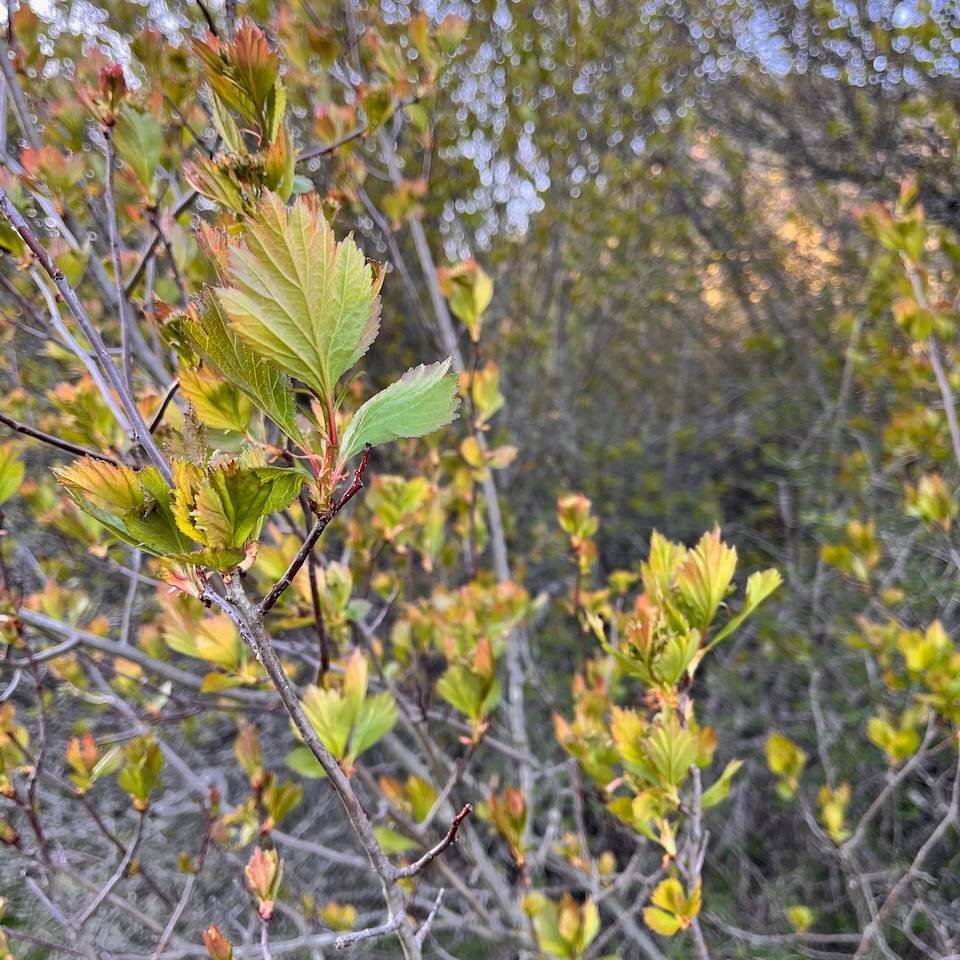Bird and habitat connections at Xwaaqw’um
Black hawthorn opening at Xwaaqw’um
It’s spring, and every day brings new arrivals from the south, especially at Xwaaqw’um, one of the birdiest spots on Salt Spring, which has a little bit of everything. As very recent settlers here, my family and I were immediately drawn to the valley and bay, sandwiched between the cooler, moist forested north-facing slope and the warm oak savannah and drier fir hillsides beneath the towering cliff of Hwmet’utsum (meaning “bent over place”, from a Quw’utsun – Cowichan – creation story about the Narrows). It was springtime then, and quickly the presence of several bird species at risk signaled that we were in a special spot. Olive-sided Flycatchers sang from the tops of the old growth firs, Band-tailed Pigeons bass-cooed from the thicker canopied trees, Common Nighthawks patrolled the air column high above the valley where their insect food rises to on warm days, and Barn Swallows urgently chased us as we approached the barns where they were nesting. Three vireo, four woodpecker, five flycatcher and six sparrow species were further evidence of a wide variety of different niches with abundant plant and invertebrate food for birds. Soon after those first visits, we learned that Xwaaqw’um was a Quw’utsun village site and spiritual centre, an important location for fishing, shellfish harvest, and food and medicine plant gardens. That helped to explain the diversity of microhabitats, even now, 200 years since Quw’utsun stewardship of the land and water was last truly active.
I have been privileged to spend 30 years working in bird conservation in different global regions and cultures. The vast majority of what I have witnessed is habitat loss and degradation, even within so-called “protected areas”. My family and I were thrilled to be warmly welcomed onto the land at Xwaaqw’um by the Quw’utsun at the Land Blessing ceremony last year, and to have the opportunity to volunteer for Stqeeye’, helping remove invasive plants to restore the Indigenous food systems that once thrived here, and sharing detailed knowledge with the Stqeeye team, about birds and some of the other animals and plants they intersect with in the different habitats at Xwaaqw’um. Stqeeye’s work at Xwaaqw’um blends Indigenous ways with western science. It is a collaboration between the Quw’utsun Tribes and the province, so it has to adhere to the rules and regulations that are applied to “crown” land and water, even though it is Quw’utsun sovereign territory.
Lately there has been some to-and-fro on the subject of invasive vegetation – exotic plants from other global regions introduced deliberately or accidentally by humans. The hawthorn Crataegus monogyna, or Mayflower, is one such tree or shrub, planted by settlers in hedgerows to form natural fences for livestock. Whilst it does provide habitat for some animals, birds and invertebrates especially, and its flowers are a source of spring nectar, its dense growth can alter the above and below ground structure of forest and oak savanna ecosystems, and it hybridizes with native Black Hawthorn Crataegus douglasii, altering the native’s gene pool and potentially creating competition for resources and pollinators within the natural system. So, it is at odds with the objectives of the habitat restoration program at Xwaaqw’um.
English Hawthorn seedling growing at Xwaaqw’um
The approach to removal of invasive hawthorn that Stqeeye’ and the province are taking is to manually remove the plants, and re-use all of the cut trees to provide woody debris structure in the wetlands being created in the valley field systems, augmenting the stumps and other woody debris that has been collected for this purpose from other parts of the island. With the spring, and the fresh arrival of birds, the piles of cut hawthorn may be used as nesting habitat by some species, so, to avoid the potential destruction of any nest (e.g., in contravention with the Migratory Bird Convention Act, or MBCA), the piles will be left in place til fall. Brush piles can provide great habitat for a wide variety of animals year-round, but the “recycling” of the wood in the wetland restoration work is the priority for the hawthorn. There are in fact a series of laws, in addition to the MBCA, that Stqeeye’ and BC Parks are taking into consideration, to ensure their approach meets regulatory requirements, including the BC Parks Act, the Water Sustainability Act, the Agricultural Land Commission Act, the Riparian Areas Protection Regulation of the Fish Protection Act, and Fisheries and Oceans timing windows to conduct projects around water. As with so many things these days, there are a mesmerizing array of regulations to navigate, many of them based on resource extraction principles rather than principles of sustaining natural systems. However, the basics of the approach being taken are that a plant that is damaging the restoration of a more natural system is being removed, in as clean and respectful a way as possible, with next to no waste, and, will contribute to the creation of biodiversity-rich new habitat.
Enjoy your time at Xwaaqw’um this spring and summer, it is a special place, and if you are passing the hawthorn piles and observe wildlife using them this, please share your observations with Stqeeye’ and BC Parks, it will be new learning and helpful to our understanding of the connections between habitats old and new, and the roles each species plays in the ecosystem.
Pete Davidson


